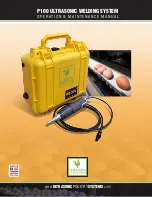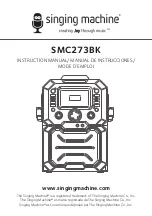
14
TROUBLE SHOOTING
No. BREAKDOWN
ANALYSIS
SOLUTIONS
1
Case Electrification
1.Primary winding run into case.
2. Secondary winding run into
case.
3. Primary and secondary winding
meet the iron core.
4. Input wire happens to touch
the case.
1. Regarding 1.2.3, disconnect the power source. Use the multimeter’s
low resistance to measure. When one stick touches the case or the iron
core while another one measures the primary and secondary winding,
that indicates an electric leakage if the second swings. Keep the case
free from being touched, and have insulation treatment between the
winding and the iron core with the same insulation materials.
2.Rid the wire or the welding cable of any position which is being
touched .
2
Big noise when it´s
switched on; power
source fuse melted
away
1.short circuit in the primary and
the secondary spool;
2. The wire adaptor meet each other.
3. Fuse too small.
1. Find out the short circuit on the winding get it repaired.
2. Keep the wires apart.
3. Replace the fuse.
3
Too small amount of
output current; No
striking or the arc be-
comes unsteady.
1.Input voltage too low and the
voltage undelates.
2. Welding cable too thin and too
long; The connection between the
earth wire and the work piece not
well secured, with the result of
too much of resistence.
3. The connection between the
welding cable and the transformer
output and not well secured, with
the result of too much of resistance.
4. Regulation screw
and nut worn out.
1. Adjust the input current up to the rated value, or increase the main
supply capacitance.
2. Enlarge the welding cable’s sectional dimension to secure a sound con-
nection between the earth wire and the work piece.
3. Secure a sound connection between the welding cable and the trans-
former output end.
4. Replace the worn-out parts.
4
The winding getting
hot, smoking and the
fuse melted away.
1. Overload running.
2. Partial short-circuit on the
primary and secondary winding.
3.Cooling fan broken.
1. Stop operation. Resume operation in conformity with the duty cycle
requirement after the winding has cooled off.
2. Repair the short-circuit part or replace the winding.
3. Repair or replace cooling fan.
5
No striking or difficult
to ignite arc after the
welder is switched on.
1. No input voltage from the
power source.
2. Switch is in off position.
3. Input wire sectional dimension
is too small or welding cable
too long.
4. Partial winding short circuit.
1. Check input power switch, fuse, input wire to enable them to work normally.
2. Turn on the switch to make the welder’s switch in on position.
3. Use a bigger wire or a welding cable.
4. Repair the short circuit area on winding.
6
Cooling fan not
working properly.
1. Starting capacitance disable
or broken.
2. Coil in fan’s motor burned out.
3. Contact failure or discon-
nection.
1. Replace the capacitor.
2. Replace winding or motor.
3. Check the wire to work out the failure.
7
Big noise when
welding.
1.Uneven gap between the
moving iron core and the static
iron core.
1. Readjust the gap between the moving iron core and the static iron
core.
8
Others
Please contact with our company.
SOLD9400.indd 14
18/08/15 14:21


































